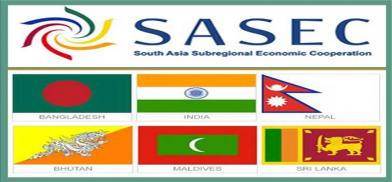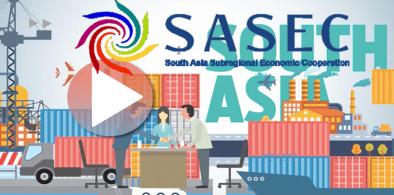South Asia needs strategic integration for closer economic cooperation
The COVID-19 pandemic which has brought about a common set of challenges to all countries of the South Asia region necessitates the need for developing and strengthening a common agenda for trade and economic cooperation, writes Partha Pratim Mitra for South Asia Monitor

As Bangladesh celebrates its 50 years of independence, the occasion also lays down a blueprint for economic cooperation in South Asia. The two neighbours, India and Bangladesh, recently agreed for greater cooperation in the energy sector and connectivity as well as a quick completion of a study on a Comprehensive Economic Partnership Agreement(CEPA). They also felt the need to reduce non-tariff barriers that hinder trade, stability of policies, regulations, and procedures.
In effect the framework for economic cooperation between any two countries or regions and more important two neighbours willing to increase trade and commerce was established.
Greater cooperation needed
The immediate economic context within which the need for greater cooperation has arisen in the region has been the COVID pandemic, which is still impacting South Asia. It had temporarily brought the region to a near halt. Governments proactively stabilized activity through monetary easing, providing fiscal stimulus, and supportive financial regulation, but the situation is fragile amidst policy challenges. The informal economy in South Asia has been severely affected. Many unorganized workers, self-employed people, and microenterprises have experienced a large drop in earnings as the service sectors that were affected most by the lockdowns are dominated by informality.
The economic context had changed very soon in South Asia, which until a few years was one of the fastest-growing regions of the world. Global GDP growth, trade, and industrial production had been stagnating over a period of time which severely affected South Asia. While South Asia was a growing region in 2018, growth remained driven by domestic demand and not exports which resulted in the growth of imports that year. The value of imports was further pushed up by rising oil prices. The turbulence in the external economic environment, however, started in 2017.
While monetary policy was being adjusted in keeping with the changing situation fiscal policy was not equally responsive and fiscal deficits remained large. Most South Asian countries generate low tax revenue and also run large fiscal deficits, often accompanied by economic shocks which limit their scope to outmaneuver economic uncertainties. In many countries, debt levels are high, and hidden liabilities in the form of off-budget debt and other fiscal liabilities are a concern. Not all these problems are present in all countries, but they all add up to a specific set of challenges in each country, putting fiscal matters at the core of development policy.
South Asia’s employment rate
In the midst of the changing economic context how the employment situation emerged in the region. Just before the pandemic which set in early 2020, it was expected that growth would further increase to 7.1 percent on average in 2019-20, reflecting an improvement across most of the region. But the question remained if countries were generating enough jobs for the youth who are a part of the demographic transition, which is a characteristic of the region. Information about employment in South Asia carried over 60 surveys and censuses from 2001 onwards. A report by the World Bank reveals that employment does respond to economic growth in the short term, implying that growth is not jobless.
Although whether growth is with or without jobs is still an open issue with countries in the region showing indications of a jobless growth. It is widely recognised that most jobs which countries in South Asia has created over the years are not fully satisfactory in terms of decent work and rapid growth alone will not be sufficient to bring South Asian employment rates to the levels observed elsewhere in the developing world in the pre-pandemic times.
The economic discourse shifted a few years ago and it was thought that the industrialised west would no longer be the growth propeller as the persistent slowdown became the new normal for advanced economies. It was thought that the centre of gravity of the world economy shifted eastwards, towards the Asia-Pacific region, which exhibited dynamism through their strategy of regional economic cooperation. But such regional economic cooperation did not gain strength in the South Asian region with intraregional trade stagnating at around 6 percent of total trade of the subregion.
The bulk of South Asia’s intraregional potential, however, remained untapped. To foster regional production networks or value chains, a report of Economic and Social Commission for Asia and the Pacific (ESCAP) in 2018 recommended the consolidation and upgrading of existing trade and investment cooperation initiatives into a South Asia Comprehensive Economic Partnership (SACEP).
SACEP could cover seven key policy priorities, such as -
*Advancing the liberalization of trade in goods,
*Strengthening facilitation of transport and trade at the land borders,
*Effective liberalization of regional trade in services,
*Investment promotion to foster regional value chains,
*Harmonizing product standards and conformity assessment procedures,
*Cumulative rules of origin and industrial cooperation,
*Coordination of international payment arrangements and banking cooperation.
Several ongoing and new policy initiatives can contribute to the fulfillment of these priorities under the composite SACEP framework. Transport, energy and people-to-people connectivity in South Asia are particularly important because of its potential to turn the subregion into a land bridge between Europe, Central Asia, and South-East Asia.
The main avenues for fostering energy connectivity in the subregion are:
*Creation of a regional power market by pursuing SAARC Power Grid and SAARC Market for Electricity Trade in Energy Sources-Oil and Gas
* Cooperation in renewable energy technologies, including sharing of knowledge and best practices; and
* Cooperation in energy resource exploration and management.
One of the important intra-South Asia cooperation arrangements to strengthen subregional economic cooperation and address development challenges such as persistent poverty and expanding demographics is the South Asia Subregional Economic Cooperation (SASEC) since 2001. The program brings together Bangladesh, Bhutan, India, Maldives, Myanmar, Nepal, and Sri Lanka in a project-based partnership model that aims to trigger regional prosperity, improve economic opportunities, and aim to build a better quality of life for the people of the subregion.
SASEC countries have a common vision of boosting intraregional trade and cooperation in South Asia, while also developing connectivity and trade with Southeast Asia. The operational priorities are the four main sectors - transport, trade facilitation, energy, and economic corridor development.
The programme has a list of potential projects regularly updated by SASEC member countries to be implemented during 2016-2025. As of June 2020, SASEC member countries have signed and implemented 61 ADB-financed investment projects worth around $13.58 billion in the transport, trade facilitation, energy, and economic corridor sectors. The transport sector has the largest number of projects (41 projects worth a cumulative $11.20 billion), followed by energy (12 projects worth $1.58 billion), economic corridor development (three projects worth $697 million), trade facilitation (three projects worth over $80.66 million), and ICT (two projects worth $20.80 million).
In the economic literature, the story of South Asia has been seen to be a topsy-turvy one. Soon after Independence from British rule, the region seemed to have a much better prospect than many other parts of the developing world, which, however, soon faded away with East and South-East Asia taking the lead. The region soon began to face a common set of challenges in the form of a low skill-base, which seems inadequate in the face of the emerging challenges of global competition and technological disruptions. Rising inequality in multiple dimensions was another challenge that attempts to weaken the foundations of long-term growth primarily due to lack of access to resources by large segments of the population which did not enable them to participate in the development process. Such an exclusionary development process resulted in a lack of adequate incomes which in turn created a narrow market base for most products.
There has also been an excessive reliance on workers’ remittances, which could jeopardize the sustainability of the region’s economic achievements owing to growing uncertainty in the oil economies of the Middle East, and the emergence of new countries which are suppliers of labour such as Vietnam, Cambodia, and Laos. Furthermore, the global problem of climate change will have far-reaching implications for the living standards of the region’s people.
South Asia needs strong trade agenda
The current reality in the wake of the pandemic and the economic downturn in the South Asian region seems to be to leave contentious and core economic policy issues internal to each country for that country to resolve on its own and there would no interference by any other country within the region. Such a resolution also includes bilateral agreements of individual countries of South Asia with other countries outside the region. While countries could follow their own individual strategies for economic cooperation but there should be an understanding between them for developing a strong agenda for trade and economic cooperation within the region.
The COVID-19 pandemic which has brought about a common set of challenges to all countries of the South Asia region necessitates the need for developing and strengthening a common agenda for trade and economic cooperation.
The main theme of such a common agenda revolves around strategic integration so that countries take advantage of each other’s facilities and capabilities. Such strategic integration is expected to maximise and develop inter-country and intra-regional trade and commerce and also ensure participation of the region with one voice globally.
(The writer is a retired Indian Economic Service officer who worked in the labour ministry. The views expressed are personal. He can be contacted at ppmitra56@gmail.com)
References:
India, Bangladesh stress on removing non-tariff bariers,Indian express, NewDelhi,March 28 2021p15.
South Asia Economic Focus, Fall 2020 : Beaten or Broken? Informality and COVID-19
South Asia Economic Focus, Fall 2019 : Making (De)centralization Work
South Asia Economic Focus, Spring 2019 : Exports Wanted
South Asia Economic Focus, Fall 2018 : Budget Crunch
(For references ii to v see https://openknowledge.worldbank.org/)
Robert Beyer,et al.
Indian Growth and Development Review
https://www.emerald.com/insight/publication/issn/1753-8254/vol/12/iss/2Volume 12 Issue 2,2019
South Asia Economic Focus, Spring 2018 : Jobless Growth?
World Bank https://openknowledge.worldbank.org
Unlocking the Potential of Regional Economic Cooperation and Integration in South Asia https://www.unescap.org/sites/default/files/publications/UNESCAP_RECI%20Report_0_Sep2018.pdf,p173-179
https://www.sasec.asia/index.php?page=what-is-sasec
Socio-economic development in South Asia The past 50 years S. R. Osmani* September 2018 WIDER Working Paper 2018/105,United Nations UniversityWorldinstitute of development Research(UNU-WIDER,)Helsinki,Finland https://www.wider.unu.edu/sites/default/files/Publications/Working-paper/PDF/wp2018-105.pdf
(NRC) internal exercise,why should we raise it?-The Express Interview with GowherRizvi,.Indian express, NewDelhi April 30,2021,P7















Post a Comment